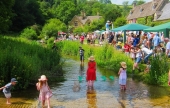I used to live in a small coastal village in Maine called Bayside. It's been a state-incorporated village municipality since 1915 when the village was purchased by the current members of the Wesleyan Campground that began at the turn of the century. Today, it's still thriving with a core of folks that are multigenerational in Bayside alongside a nice diversity of newer folks from all over the country who wanted to settle in a beautiful, safe, and socially warm and inviting, true village. The main historical district is composed of cozily situated, small Victorian cottages that evolved from the tent platforms of the meeting ground. Newer homes cover the hillside and shores of Penobscot Bay. It's definitely a middle-class family village in home size. What makes Bayside a village is really its village culture, one that is rooted in the neighborly New England traditions of respect, civility, and community that is reinforced by an active social life of village events, village organizations, as well as meeting groups of friends. Along with village celebrations of all the American holidays, it has an arts and culture organization that puts on events, an inexpensive yacht club for everyone even if without a boat, a historical society, a garden club, and many more organizations that come and go with interests. As I did, folks want to live in Bayside for its village community culture, of working with each other for the common good, its inclusive diversity, and its family safe and caring environment. Everyone knows and respects each other, regardless of politics, income, or ethnicity, because that's just what happens in its village culture. Folks come and go, are born or pass on, but the village remains the same, now for well over a century, because of its timeless culture.







